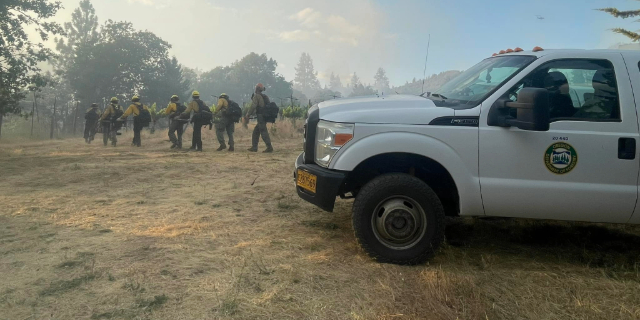Jackson County commissioners praise fire officials for aggressive 2023 response
Published 3:00 pm Tuesday, November 21, 2023

- Firefighters with Central Oregon’s Fire Management Service work to mop up hot spots Tuesday at a fireline on the Flat Fire 13 miles east of Gold Beach.
Jackson County commissioners heaped praise on top fire officials Tuesday for their work this year to keep southwestern Oregon wildfires small, and they pledged to lobby for them at the state and federal level as the cost for service grows.
Dave Larson, Oregon Department of Forestry Southwest District director, and Rogue River-Siskiyou National Forest fire staff officer Dan Quinones each touted hard-fought successes in the 2023 fire season. They also shed new details about some of the largest fires and the firefights needed to keep them small.
For example, Quinones said at one point in July, his agency fully depleted the Medford airport of fire retardant while crews worked to stop the Flat Fire from spreading as it threatened the rural Curry County community of Agness.
“Really good season overall … but it wasn’t for lack of trying,” Quinones said.
Quinones said he intends to follow the same policy of aggressive initial attack — no matter the boundary — set by former Rogue River-Siskiyou National Forest Supervisor Merv George Jr. George was promoted to a position as the deputy regional forester with the U.S. Forest Service in Portland.
“Our stance at the Rogue River-Siskiyou National Forest is to put out fires as quickly as possible, as safely as possible, as small as possible,” Quinones told commissioners. “We’re going to maintain that stance as long as I’m in this position.”
Jackson County Commissioner Rick Dyer told Quinones that he’s “relieved and encouraged” to see the aggressive initial attack policy continue to be embraced.
Commissioner Colleen Roberts concurred.
“It shows in Jackson County,” Roberts said.
Quinones’ district saw 93 fires this year that burned 56,643 acres. The majority of that acreage was from the Flat Fire, which burned 34,424 acres in Josephine and Curry counties.
The Flat Fire was human-caused, Quinones said, adding with sarcasm “the best day if you want to have a large running fire to be careless. That’s really what happened.”
Quinones said crews pounced on the Flat Fire “immediately” and “sent everything we possibly had.”
The fire broke in the scar of some of the state’s largest wildfires, such as the 2002 Biscuit Fire, which burned half a million acres; the 2017 Chetco Bar Fire, which burned about 191,000 acres; and the 2018 Klondike Fire, which burned 170,000 acres.
Keeping the Flat Fire contained to 34,000 acres with no homes lost was without rain, “just sheer work,” Quinones said.
Larson called the ODF Southwest District’s fire season “highly successful.”
Excluding the Smith River Complex, which burned more than 95,000 acres primarily in Northern California and about 1,500 acres in Josephine County, Larson said that ODF had 205 fires in Jackson and Josephine counties with 194 acres burned.
“That’s exceptional,” Larson said, adding that ODF’s 10-year averages are in excess of about 10,000 acres.
Lightning was the second-leading cause of fires in the region this summer, sparking 47 fire starts.
The leading cause of fires this year was “equipment,” Larson said, linked to 59 fires that burned 55 acres. He described the category as “kind of a catch-all” including fires caused by vehicles, lawnmowers and power lines.
The season lasted 134 days, including 80 days in “high” or “extreme fire danger. The average fire season lasts 138 days.
The largest fire in Jackson County was a human-caused fire July 20 near Table Rock and Latigo roads in Central Point, which ultimately grew to 65 acres. It prompted the only Level 3 “Go” evacuation in the county this year, which lasted two hours, according to Jackson County Emergency Manager Holly Powers.
Some 15 emergency alerts were issued during fire season using the county’s Everbridge citizen alert system including nine general alerts, two Level 1 evacuation alerts, two Level 2 evacuations, the Level 3 evacuation and a countywide Red Flag Warning alert.
Powers told commissioners that Jackson County Emergency Management is working with the Jackson County Sheriff’s Office to communicate that a citizen alert is equivalent in notification to a door knock from a deputy. In some situations, notifications won’t go out.
“Sometimes the door knock is going to be more effective and efficient because we have that staff on the ground ready to do it,” Powers said. “We have to understand the full impact of the fire, while those on the ground are going to protect life first.”
Jackson County Administrator Danny Jordan said that the county was criticized for not using the alert system extensively during the Central Point fire when sheriff’s deputies were already at the scene. He said that level of alert isn’t always feasible.
“Primarily, if we start sending citizen alerts on every fire, we start overwhelming the 911 dispatch system, and we get people all panicked and confused about what’s really going on,” Jordan said.
Jordan asked Larson if he sees “any funding issues coming up” in the 2024 Oregon legislative session that begins in Februrary.
Larson touched on the cost of suppressing fires, especially at current levels of service, due to a combination of fire seasons trending longer and deteriorating forest health. In the southwest Oregon district, ODF’s rates of service come down to almost $4 an acre at the private level and almost $8 an acre on public lands — and rising.
“All these things break down to the perfect storm. It just comes down to money,” Larson said.
Larson said they’re planning to submit “a standard suite of requests” for the upcoming fire season, including ODF’s severity program — a request about $10 million over its standard “adequate level of protection” budget — which among other resources includes the contract for the large air tanker stationed at the Medford airport.
Jordan asked Larson to meet with the county again once ODF’s proposals to the Legislature are completed to discuss ways the county can vouch for them in Salem — especially the $10 million ask — “because we know how important that is.”






